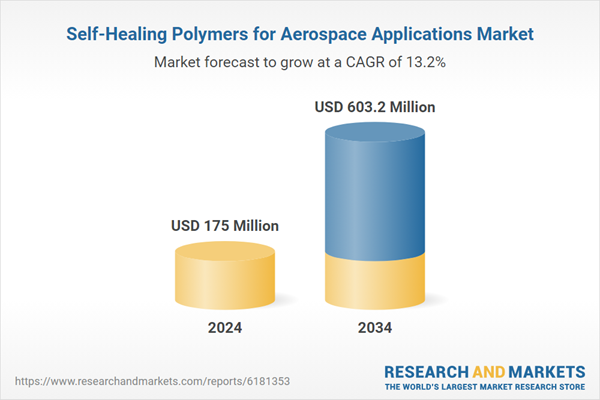The growth is driven by advancements in polymer technology aimed at improving aircraft maintenance. Self-healing polymers are becoming increasingly important in aerospace as they are designed to repair micro-cracks and damage before it is visible to inspectors, reducing the need for frequent maintenance. These technologies, such as capsule-filled epoxies, vascular carbon-fiber reinforced polymers (CFRPs), and dynamic covalent thermoplastics, are proving effective in extending the life cycle of aircraft parts. The adoption of self-healing systems has expanded from coatings to critical structural components, and major aerospace players are now exploring their integration directly into primary structures to improve durability and reduce weight. As regulations become stricter, especially regarding the environmental impact of aerospace materials, the demand for self-healing polymers continues to rise. The latest sustainable aviation initiatives, such as the EU’s roadmap targeting 50% composite recyclability by 2035, are further propelling market growth.
The extrinsic self-healing systems segment is forecasted to grow at a CAGR of 13% from 2025 to 2034. This segment benefits from a hybrid approach that combines capsule, vascular, and intrinsic systems, offering a more durable and manufacturable solution that reduces aircraft inspection intervals by up to 15%. This integrated system is poised to become a standard feature in next-generation narrow-body aircraft expected to launch in 2028.
The commercial aviation segment was valued at USD 89.7 million in 2024. The integration of self-healing technology into structural components during early production stages is gaining momentum. The adoption of self-healing polymers is increasingly driven by production-rate increases, digital twin models, and stricter damage-tolerance regulations. By incorporating self-healing materials from the outset, OEMs can achieve more predictable repair cycles and long-term cost savings.
North America Self-Healing Polymers for Aerospace Applications Market generated USD 65.9 million in 2024 and is expected to reach USD 219.8 million by 2034. The primary driver is the growing demand from the aerospace industry, particularly in the U.S., which accounted for USD 56.5 million in 2024. This market is benefiting from a robust commercial aircraft production sector, alongside the U.S. military’s push for condition-based maintenance. The adoption of advanced self-healing technologies is being accelerated by tax incentives, research grants, and a well-established maintenance, repair, and overhaul (MRO) network.
The leading companies in the Global Self-Healing Polymers for Aerospace Applications Market include Autonomic Materials Inc., Arkema, Evonik Industries AG, BASF SE, and Solvay SA. To enhance their market position, companies are pursuing multiple strategies, including investing heavily in R&D to develop more efficient and cost-effective self-healing polymer technologies. They are also focusing on expanding their product offerings by integrating self-healing materials directly into primary aircraft structures, thereby improving durability, reducing weight, and increasing manufacturing efficiency. Strategic partnerships with aerospace OEMs and suppliers are being forged to ensure the seamless integration of self-healing systems into aircraft production lines. Furthermore, these companies are actively working to meet stringent environmental and regulatory standards, such as recyclability goals, by developing sustainable, bio-based materials.
Comprehensive Market Analysis and Forecast
- Industry trends, key growth drivers, challenges, future opportunities, and regulatory landscape
- Competitive landscape with Porter’s Five Forces and PESTEL analysis
- Market size, segmentation, and regional forecasts
- In-depth company profiles, business strategies, financial insights, and SWOT analysis
This product will be delivered within 2-4 business days.
Table of Contents
Companies Mentioned
The companies profiled in this Self-Healing Polymers for Aerospace Applications market report include:- SCHOTT Pharma AG & Co. KGaA
- Gerresheimer AG
- Stevanato Group S.p.a.
- West Pharmaceutical Services, Inc.
- Becton, Dickinson and Company (BD)
- Ypsomed AG
- Owen Mumford Ltd.
- SHL Medical AG
- Haselmeier GmbH
- Phillips-Medisize (a Molex company)
- Nemera
- Credence MedSystems, Inc.
- Terumo Corporation
- Kraton Corporation
- Datwyler Holding Inc.
Table Information
| Report Attribute | Details |
|---|---|
| No. of Pages | 184 |
| Published | October 2025 |
| Forecast Period | 2024 - 2034 |
| Estimated Market Value ( USD | $ 175 Million |
| Forecasted Market Value ( USD | $ 603.2 Million |
| Compound Annual Growth Rate | 13.2% |
| Regions Covered | Global |
| No. of Companies Mentioned | 15 |









